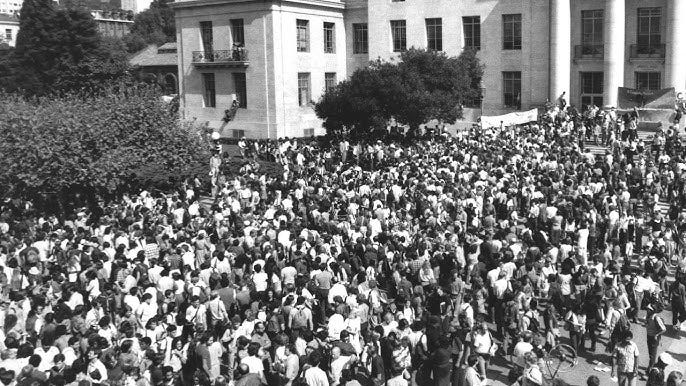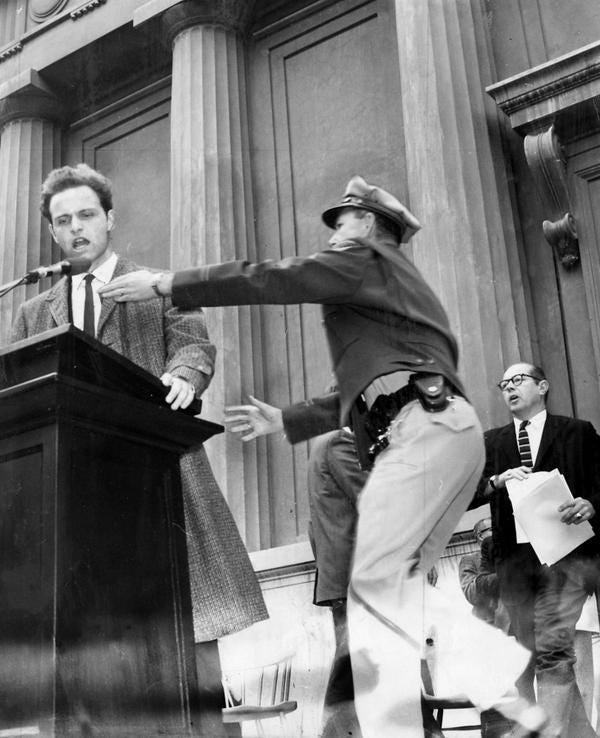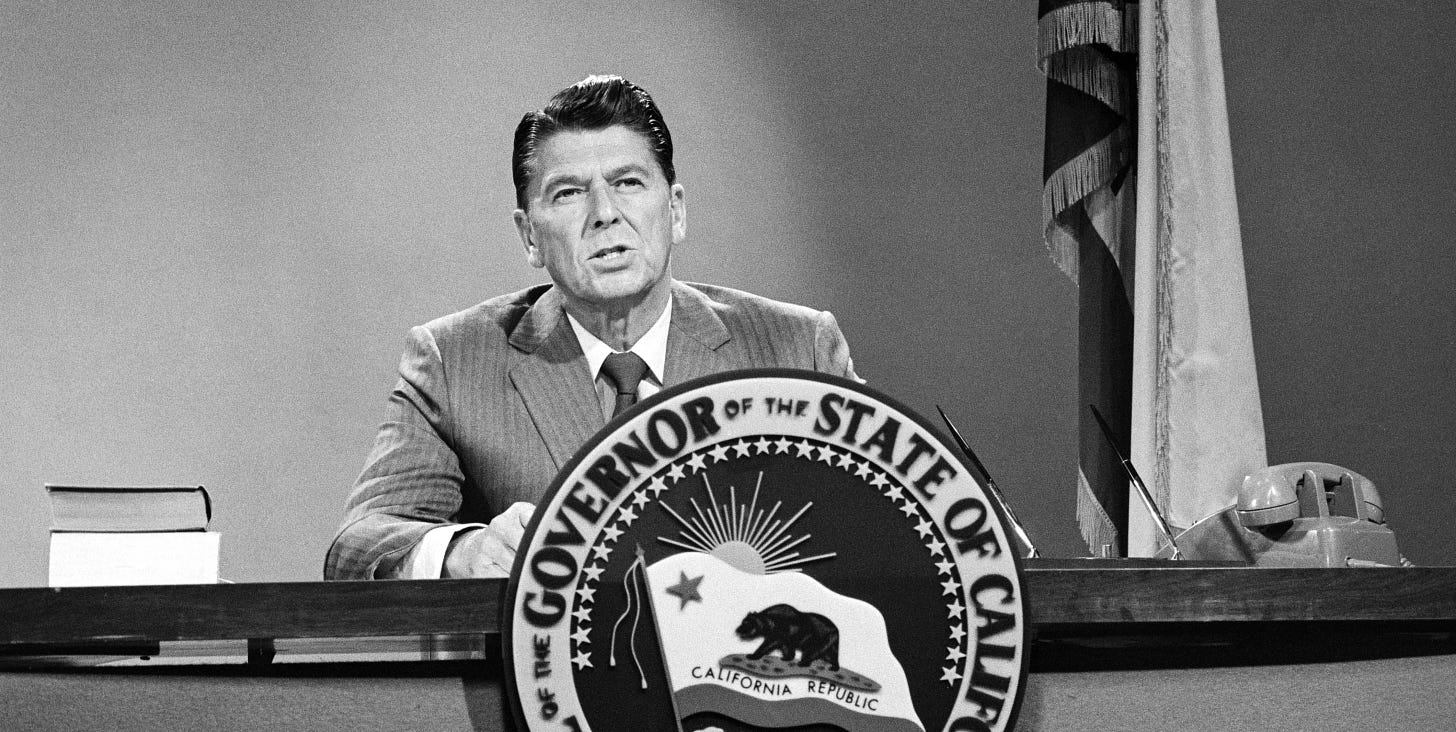Friends,
In September 1964, university officials at Berkeley banned students from using the campus for political causes. The officials had been under pressure from the Board of Regents to ban expression of views considered communist. America was still in the grasp of communist witch hunts by the FBI and the House Un-American Activities Committee. Berkeley hoped that keeping the university and its students out of politics would reduce the likelihood of politicians meddling in campus affairs.
By order of Vice Chancellor Alex Sherriffs (who, it later turned out, was a secret informer for the FBI) the university extended the ban to include students who set up card tables and leafleted for civil rights and other causes at the entrance to campus along a public area on Telegraph Avenue.
Berkeley students claimed that the crackdown was a violation of their constitutional right to free speech and an attack on the Civil Rights Movement. They tried negotiating with campus officials but got nowhere.
On October 1, a mathematics graduate student named Jack Weinberg was arrested for setting up an information table on the plaza in front of Sproul Hall, the administration building, on behalf of the Congress of Racial Equality.
When campus police drove onto the plaza to arrest him, thousands of Berkeley students spontaneously sat down around the police car and held it captive for 33 hours in protest of the university rule against political activity on campus. Finally, the university administration and the protesters agreed to a truce, and the students released the car.
Over the next days, the demonstrators named themselves the Free Speech Movement. The FSM set up an executive committee, with representatives of campus groups ranging from the Young Socialists to the Young Republicans. A steering committee of 11 handled day-to-day decisions, but the FSM’s larger strategic decisions were based on mass meetings and consensus.
Yet the ban on political activity continued. When negotiations between the FSM and the administration failed, FSM members marched to where the university’s Board of Regents was meeting. Although the regents did not allow students to speak, they decided to allow limited political advocacy on campus.
The movement was reignited when the university filed legal charges against FSM leaders for the police car protest and the FBI planted a story in the San Francisco Examiner charging the FSM with being a communist front group.
On December 2, the FSM rallied on Sproul Plaza. Mario Savio, a graduate student and one of the FSM’s leaders, said to the crowd:
There’s a time when the operation of the machine becomes so odious, makes you so sick at heart, that you can’t take part. You can’t even passively take part. And you’ve got to put your bodies upon the gears and upon the wheels, upon the levers, upon all the apparatus, and you’ve got to make it stop. And you’ve got to indicate to the people who run it, to the people who own it, that unless you’re free the machine will be prevented from working at all!
After the speech, more than a thousand students filed slowly into Sproul Hall and occupied all four floors.
California Governor Edmund G. “Pat” Brown initially agreed to take no action against the protesters, allowing them to leave the building with impunity. Hours later, Brown changed his mind and ordered the largest mass arrest in decades.
Nearly half of all Berkeley students boycotted classes in protest.
On December 7, university president Clark Kerr called a campus-wide meeting in Berkeley’s large outdoor Greek Theater, where he agreed to further ease the ban but not rescind it entirely.
Just as Kerr finished speaking, Savio, in suit and tie, strode to the podium, although he had been denied permission to speak. Police officers grabbed him by the throat and dragged him to the ground as the packed theater let out a collective gasp. After the crowd chanted, “Let him speak!” Savio was allowed to return to the stage and say a few words.
But the police officers’ excessive force angered many in the university, and the next day Berkeley’s faculty voted to back the FSM’s demand to repeal the ban entirely. A few weeks later, the university’s Board of Regents conceded that students had full constitutional rights on campus.
The FSM established that students have the fundamental right to free speech necessary for participation as full-fledged individuals. It sparked mass protests and demonstrations at other universities across the nation and helped inspire the antiwar, ethnic studies, women’s, gay rights, and environmental movements. The FSM stands as a model for nonviolent mass organizations built on transparency and consensus.
The FSM won, but the win came at a political price.
By late 1965, Ronald Reagan was considering a run for California governor. He had come to the state to be an actor and once in Hollywood became president of the Screen Actors Guild. (He also became an FBI informer, sometimes naming fellow actors on the scantiest of evidence.)
Reagan’s talks gradually became more political. They evolved into an impassioned critique of what he saw as a complacent, if not morally corrupt, system. Like Savio, Reagan attacked bureaucracy, elitism, and the loss of individual freedom. But Savio’s critique emerged from the Civil Rights Movement; Reagan’s, from what he deemed unwarranted government intrusion into American life.
As Reagan campaigned around the state, he heard about the trouble at Berkeley. Many Californians, accustomed to the campus complacency of the 1950s, were shocked by the student protests. Reagan tapped into their anger and resentment, thundering:
Will we allow a great University to be brought to its knees by a noisy, dissident minority? Will we meet their neurotic vulgarities with vacillation and weakness? Or will we tell those entrusted with administering the University we expect them to enforce a code based on decency, common sense, and dedication to the high and noble purpose of the University?
Reagan later claimed, erroneously, that applications to Berkeley had decreased because of the turmoil. When university officials said they were actually on the rise, Reagan countered that it was only because the school had lowered standards.
In the November 1966 election, Reagan defeated Pat Brown by nearly 1 million votes and instantly transformed into a national political figure.
In one of his first acts as governor, Reagan requested a private FBI briefing on Kerr and the protests at Berkeley. Several weeks later, at the first regents’ meeting attended by Reagan, the regents fired Kerr.
While Brown had not attended most regents’ meetings, Reagan made a point of attending them, often holding press conferences that turned the meetings into media spectacles.
Reagan cut the university’s budget and pushed the regents to impose fees — in effect, the first tuition in the school’s history. Reagan continued to charge campus misconduct, heightening public outrage. He complained about “subsidizing intellectual curiosity,” and his auditors suggested the university sell its rare book collection to generate state revenue.
None of this quelled the unrest at Berkeley, but Reagan’s attacks undermined public support for higher education in general.
The FSM also gave Ronald Reagan the public platform he used to become president of the United States — one of the most reactionary leaders in living memory.







The start of the GQP war on higher education.
Ronnie Rayguns - the gift that keeps on giving and the beginning of today’s insanity. Oops! Almost forgot about Nixon and his reign of terror.